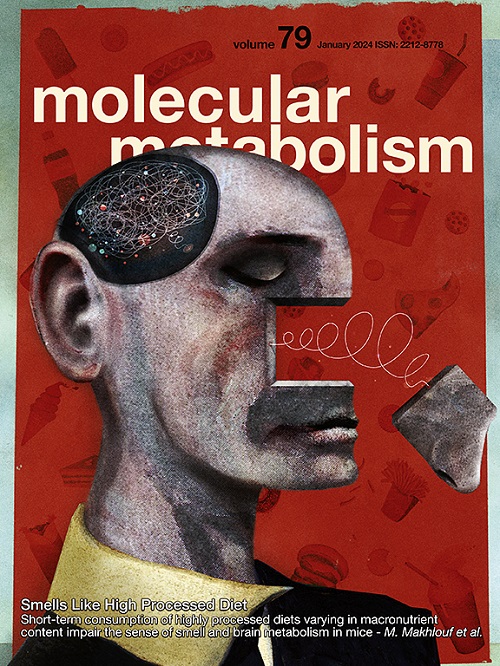丙酮酸激酶缺乏将代谢紊乱与神经变性和轴突保护联系起来。
IF 6.6
2区 医学
Q1 ENDOCRINOLOGY & METABOLISM
引用次数: 0
摘要
神经元依赖于严格调控的代谢网络来维持其高能量需求,特别是通过糖酵解、柠檬酸循环和氧化磷酸化的耦合。在这里,我们研究了丙酮酸激酶(pyruvate kinase, PyK),一种关键的糖酵解酶,在维持黑腹果蝇神经肌肉系统轴突和突触完整性中的作用。利用PyK的遗传缺陷,我们发现破坏糖酵解诱导进行性突触和轴突变性以及严重的运动缺陷。这些作用需要保守的双亮氨酸拉链激酶(DLK,果蝇中的Wallenda/Wnd)、Jun n -末端激酶(JNK)和激活蛋白1 (AP-1) Fos转录因子轴突损伤信号通路以及轴突退化的关键驱动因子SARM1 NADase酶。由于DLK和SARM1都能调节受损轴突的变性(沃勒氏变性),我们探讨了PyK缺失对这一过程的影响。与代谢变化可能以情境依赖的方式影响神经元恢复的观点一致,我们发现pyk敲低可延迟神经损伤后的沃勒氏变性,这表明减少糖酵解通量可以促进应激条件下轴突的存活。这种保护作用被DLK敲低部分阻断,并被SARM1过表达完全消除。总之,我们的研究结果通过证明糖酵解扰动会激活应激反应途径,根据系统状态决定保护和退化之间的平衡,从而帮助连接代谢和神经退行性信号。这些结果为理解代谢对神经变性的贡献提供了一个机制框架,并强调了代谢作为治疗策略目标的潜力。本文章由计算机程序翻译,如有差异,请以英文原文为准。

Pyruvate kinase deficiency links metabolic perturbations to neurodegeneration and axonal protection
Objective
Metabolic disruption is a central feature to many neurodegenerative diseases. Despite this, many gaps exist in our understanding of how these perturbations link to the mechanisms of neural disease. In this study, we sought to understand how genetically-controlled, cell-specific loss of pyruvate kinase (PyK) impacts motor neuron synaptic integrity and how the canonical neurodegenerative proteins DLK and SARM1 respond to this break in homeostasis.
Methods
This study made use of the genetically-tractable Drosophila melanogaster to cell-specifically express proteins (via the GAL4/UAS binary system), knockdown gene transcripts (via RNA interference), and knockout gene loci (via guide RNA-directed Cas9). Synaptic and axonal degeneration were measured through immunohistochemistry, microscopy, and blinded scoring of fly larvae at both early and later 3rd instar stages to test for progressive phenotypes. Nervous system injury through a physical nerve crush assay was used to assay functional outcomes of protective stress responses.
Results
We found that knockdown or knockout of PyK results in progressive axonal and synaptic degeneration, dependent on signaling through DLK and SARM1. This degeneration is preceded by nuclear transcriptional activation by DLK and the downstream AP-1 transcription factor Fos. We also found evidence of a neuroprotective response through injury of PyK-deficient axons (before progressive degeneration has occurred), which results in delayed Wallerian degeneration. This delay shows dependence on DLK and Fos, and coincides with reduced axonal localization of SARM1 whose overexpression fully restores degeneration speed.
Conclusions
These data support a rheostat model of DLK signaling that both promotes and inhibits axon degeneration in response to metabolic disruption. This rheostat likely converges on regulation of SARM1, which is required for the progressive synapse loss following PyK, but also abolishes the protective delay in injury-induced Wallerian degeneration when overexpressed. Overall, we conclude that metabolic signaling through PyK is essential for the integrity of motor neuron axons and synapses, and that its disruption activates both neurodegenerative and neuroprotective mechanisms
求助全文
通过发布文献求助,成功后即可免费获取论文全文。
去求助
来源期刊

Molecular Metabolism
ENDOCRINOLOGY & METABOLISM-
CiteScore
14.50
自引率
2.50%
发文量
219
审稿时长
43 days
期刊介绍:
Molecular Metabolism is a leading journal dedicated to sharing groundbreaking discoveries in the field of energy homeostasis and the underlying factors of metabolic disorders. These disorders include obesity, diabetes, cardiovascular disease, and cancer. Our journal focuses on publishing research driven by hypotheses and conducted to the highest standards, aiming to provide a mechanistic understanding of energy homeostasis-related behavior, physiology, and dysfunction.
We promote interdisciplinary science, covering a broad range of approaches from molecules to humans throughout the lifespan. Our goal is to contribute to transformative research in metabolism, which has the potential to revolutionize the field. By enabling progress in the prognosis, prevention, and ultimately the cure of metabolic disorders and their long-term complications, our journal seeks to better the future of health and well-being.
 求助内容:
求助内容: 应助结果提醒方式:
应助结果提醒方式:


